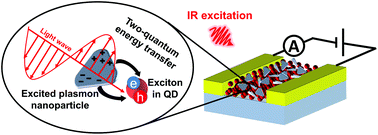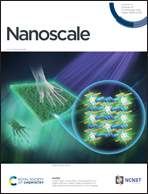Plasmon–exciton interaction strongly increases the efficiency of a quantum dot-based near-infrared photodetector operating in the two-photon absorption mode under normal conditions†
Abstract
Semiconductor quantum dots (QDs) are known for their high two-photon absorption (TPA) capacity. This allows them to efficiently absorb infrared photons with energies lower than the bandgap energy. Moreover, TPA in QDs can be further enhanced by the interaction of excitons of the QDs with plasmons of a metal nanoparticle. We fabricated nonlinear plasmon–exciton photodetectors based on QDs and silver nanoplates (SNPs) to demonstrate the optoelectronic application of these effects. A thin layer of CdSe QDs was used as a source of charge carriers for a photoresistor-type photodetector. SNPs with near-infrared plasmon modes were introduced into the layer of QDs to increase the light absorption efficiency. Under near-infrared irradiation, the power of the dependence of the photocurrent on the excitation intensity was twice the power of the corresponding dependence under one-photon excitation with visible light. This proved that the new photodetector efficiently operated under two-photon excitation. Although the SNP light absorption was linear, energy was transferred from plasmons to excitons in the two-quantum mode, which led to a nonlinear dependence. Moreover, we found that the photocurrent from the designed photodetector containing the QD–SNP composite was an order of magnitude higher than that from a photodetector containing QDs alone. This can be explained by the plasmon-induced increase in the TPA efficiency.



 Please wait while we load your content...
Please wait while we load your content...